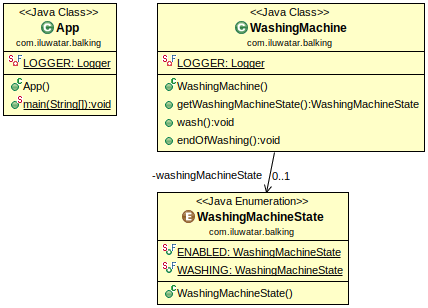Balking
Intent
Balking Pattern is used to prevent an object from executing a certain code if it is in an incomplete or inappropriate state. If the state is not suitable for the action, the method call is ignored (or "balked").
Explanation
Real world example
There's a start-button in a washing machine to initiate the laundry washing. When the washing
machine is inactive the button works as expected, but if it's already washing the button does
nothing.
In plain words
Using the balking pattern, a certain code executes only if the object is in particular state.
Wikipedia says
The balking pattern is a software design pattern that only executes an action on an object when
the object is in a particular state. For example, if an object reads ZIP files and a calling
method invokes a get method on the object when the ZIP file is not open, the object would "balk"
at the request.
Programmatic Example
In this example implementation, WashingMachine is an object that has two states in which it can
be: ENABLED and WASHING. If the machine is ENABLED, the state changes to WASHING using a thread-safe
method. On the other hand, if it already has been washing and any other thread executes wash()
it won't do that and returns without doing anything.
Here are the relevant parts of the WashingMachine class.
@Slf4j
public class WashingMachine {
private final DelayProvider delayProvider;
private WashingMachineState washingMachineState;
public WashingMachine(DelayProvider delayProvider) {
this.delayProvider = delayProvider;
this.washingMachineState = WashingMachineState.ENABLED;
}
public WashingMachineState getWashingMachineState() {
return washingMachineState;
}
public void wash() {
synchronized (this) {
var machineState = getWashingMachineState();
LOGGER.info("{}: Actual machine state: {}", Thread.currentThread().getName(), machineState);
if (this.washingMachineState == WashingMachineState.WASHING) {
LOGGER.error("Cannot wash if the machine has been already washing!");
return;
}
this.washingMachineState = WashingMachineState.WASHING;
}
LOGGER.info("{}: Doing the washing", Thread.currentThread().getName());
this.delayProvider.executeAfterDelay(50, TimeUnit.MILLISECONDS, this::endOfWashing);
}
public synchronized void endOfWashing() {
washingMachineState = WashingMachineState.ENABLED;
LOGGER.info("{}: Washing completed.", Thread.currentThread().getId());
}
}
Here's the simple DelayProvider interface used by the WashingMachine.
public interface DelayProvider {
void executeAfterDelay(long interval, TimeUnit timeUnit, Runnable task);
}
Now we introduce the application using the WashingMachine.
public static void main(String... args) {
final var washingMachine = new WashingMachine();
var executorService = Executors.newFixedThreadPool(3);
for (int i = 0; i < 3; i++) {
executorService.execute(washingMachine::wash);
}
executorService.shutdown();
try {
executorService.awaitTermination(10, TimeUnit.SECONDS);
} catch (InterruptedException ie) {
LOGGER.error("ERROR: Waiting on executor service shutdown!");
Thread.currentThread().interrupt();
}
}
Here is the console output of the program.
14:02:52.268 [pool-1-thread-2] INFO com.iluwatar.balking.WashingMachine - pool-1-thread-2: Actual machine state: ENABLED
14:02:52.272 [pool-1-thread-2] INFO com.iluwatar.balking.WashingMachine - pool-1-thread-2: Doing the washing
14:02:52.272 [pool-1-thread-3] INFO com.iluwatar.balking.WashingMachine - pool-1-thread-3: Actual machine state: WASHING
14:02:52.273 [pool-1-thread-3] ERROR com.iluwatar.balking.WashingMachine - Cannot wash if the machine has been already washing!
14:02:52.273 [pool-1-thread-1] INFO com.iluwatar.balking.WashingMachine - pool-1-thread-1: Actual machine state: WASHING
14:02:52.273 [pool-1-thread-1] ERROR com.iluwatar.balking.WashingMachine - Cannot wash if the machine has been already washing!
14:02:52.324 [pool-1-thread-2] INFO com.iluwatar.balking.WashingMachine - 14: Washing completed.
Class diagram

Applicability
Use the Balking pattern when
- You want to invoke an action on an object only when it is in a particular state
- Objects are generally only in a state that is prone to balking temporarily but for an unknown
amount of time - In multithreaded applications where certain actions should only proceed when specific conditions are met, and those conditions are expected to change over time due to external factors or concurrent operations.
Known Uses:
- Resource pooling, where resources are only allocated if they are in a valid state for allocation.
- Thread management, where threads only proceed with tasks if certain conditions (like task availability or resource locks) are met.
Consequences:
Benefits:
- Reduces unnecessary lock acquisitions in situations where actions cannot proceed, enhancing performance in concurrent applications.
- Encourages clear separation of state management and behavior, leading to cleaner code.
- Simplifies the handling of operations that should only be performed under certain conditions without cluttering the caller code with state checks.
Trade-offs:
- Can introduce complexity by obscuring the conditions under which actions are taken or ignored, potentially making the system harder to debug and understand.
- May lead to missed opportunities or actions if the state changes are not properly monitored or if the balking condition is too restrictive.